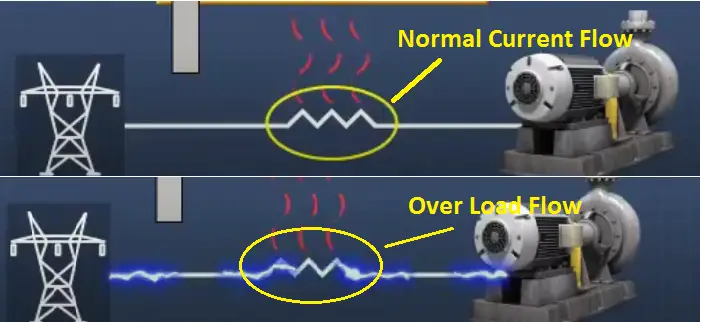Difference Between Short circuit and overloading:
Short circuit and overloading are the faults which are needs to be reduced to increase productivity. The main difference between Short circuit and overloading fault is that the contact between two-phase caused short circuit and the flow of current is more than the rated current is called overloading.
The maximum allowable current details can be collected from the nameplate details. The short circuit is a term which is mostly used in circuit breaker and overload is a term which is used in the electrical motor.
What is Short circuit Fault:
A short circuit can be defined as the unplanned connection between two conductors is called a short circuit. It occurs between phase to phase, phase to ground and phase to the same phase.

In this, the phase to phase short circuit is very dangerous and which creates a high current flow through the conductor than the phase to ground and phase to the same phase fault.
Now you will get doubt about why high current is created on the short circuit? Technically, the resistance between the two conductors will become approximately zero on the short circuit. Here the entire line voltage will be dropped across the small resistance. As you know the resistance is indirectly proportional to the current as per Ohms’ law. Hence the current becomes high.
Overloading Fault
Overloading is nothing but a flow of actual current which is higher than the allowable limit. Technically overload is not a fault. Look at the figure for a better understanding.

i.e A three-phase motor full load current is 55A and the protective equipment is designed to trip the circuit in 55A. If the current is more than 56A means, the relay will trip the circuit. This kind of fault is generally called as overload fault.
It is not dangerous to the machine. Electrical equipment manufacture always designs equipment to withstand up to 10s.
The voltage drop across the equipment will be less approximately 80 to 95% of the full load voltage.
Short Circuit vs Overloading
Difference Between Short Circuit and Overloading |
||
| Short circuit | OverLoading | |
| Definition | contact between two phases | the flow of current more than rated current |
| Dangerous | High, | Less |
| Current | High current flows typically 6 to 10 times of the full load current | Less current flows, typically 100 to 200% |
| Protective devices | Circuit breakers, MPR relays or magnetic type relays are used to control. | Simple thermal overload relays are enough to control overloading fault |
| Fault occurrence | Rare | Frequently, Once in a day |
| Voltage | Across the voltage is zero | During overload fault, only 10% of the voltage will be reduced. |
| Tripping time | The tripping time of the breaker will be 0.02s but The CB will trip the circuit in 0.5 Sec only. | Maximum overload tripping time setting will be 10s. |
| Damage measurement | very high, it burns the equipment fully. | Very less, equipment failure is very rare. |
| Relay co-ordination | Required | required with the upstream breakers. |
| causes of fault | Nature, insulation failure | Mechanical aspects like Jam |
| Voltage reduction | reduction of voltage does not cause the short circuit | Reduction of the applied voltage leads to overloading fault for the same load. |
| Fault Tracing | Difficult | Very easy |
